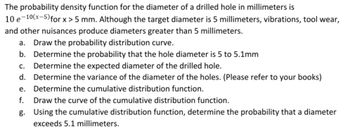The probability density function for the diameter of a drilled hole in millimeters is 10 e 10(x-5) for x>5 mm. Although the target diameter is 5 millimeters, vibrations, tool wear, and other nuisances produce diameters greater than 5 millimeters. a. Draw the probability distribution curve. b. Determine the probability that the hole diameter is 5 to 5.1mm c. Determine the expected diameter of the drilled hole.
The probability density function for the diameter of a drilled hole in millimeters is 10 e 10(x-5) for x>5 mm. Although the target diameter is 5 millimeters, vibrations, tool wear, and other nuisances produce diameters greater than 5 millimeters. a. Draw the probability distribution curve. b. Determine the probability that the hole diameter is 5 to 5.1mm c. Determine the expected diameter of the drilled hole.
Calculus For The Life Sciences
2nd Edition
ISBN:9780321964038
Author:GREENWELL, Raymond N., RITCHEY, Nathan P., Lial, Margaret L.
Publisher:GREENWELL, Raymond N., RITCHEY, Nathan P., Lial, Margaret L.
Chapter13: Probability And Calculus
Section13.3: Special Probability Density Functions
Problem 1E
Related questions
Question
100%
answer a,b, and c

Transcribed Image Text:2. The probability density function for the diameter of a drilled hole in millimeters is
10 e 10(x-5) for x>5 mm. Although the target diameter is 5 millimeters, vibrations, tool wear,
and other nuisances produce diameters greater than 5 millimeters.
a. Draw the probability distribution curve.
b. Determine the probability that the hole diameter is 5 to 5.1mm
Determine the expected diameter of the drilled hole.
C.
3.
Expert Solution
This question has been solved!
Explore an expertly crafted, step-by-step solution for a thorough understanding of key concepts.
This is a popular solution!
Trending now
This is a popular solution!
Step by step
Solved in 4 steps with 2 images

Follow-up Questions
Read through expert solutions to related follow-up questions below.
Follow-up Question
Please answer d, e, f, and g to get a like

Transcribed Image Text:The probability density function for the diameter of a drilled hole in millimeters is
10 e 10(x-5) for x>5 mm. Although the target diameter is 5 millimeters, vibrations, tool wear,
and other nuisances produce diameters greater than 5 millimeters.
a. Draw the probability distribution curve.
b. Determine the probability that the hole diameter is 5 to 5.1mm
c. Determine the expected diameter of the drilled hole.
d.
Determine the variance of the diameter of the holes. (Please refer to your books)
e. Determine the cumulative distribution function.
f. Draw the curve of the cumulative distribution function.
g.
Using the cumulative distribution function, determine the probability that a diameter
exceeds 5.1 millimeters.
Solution
Recommended textbooks for you

Calculus For The Life Sciences
Calculus
ISBN:
9780321964038
Author:
GREENWELL, Raymond N., RITCHEY, Nathan P., Lial, Margaret L.
Publisher:
Pearson Addison Wesley,

Calculus For The Life Sciences
Calculus
ISBN:
9780321964038
Author:
GREENWELL, Raymond N., RITCHEY, Nathan P., Lial, Margaret L.
Publisher:
Pearson Addison Wesley,